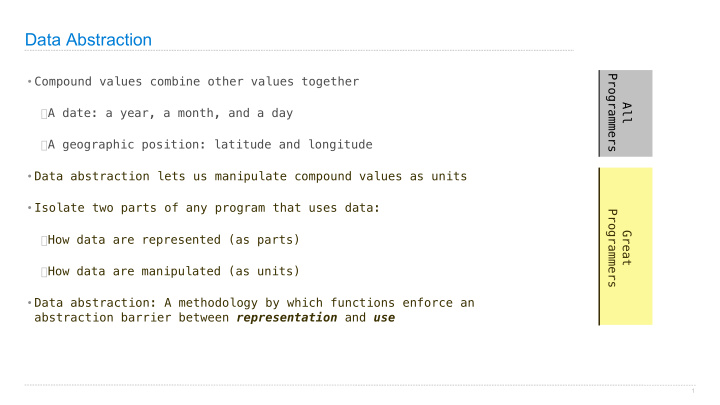



Data Abstraction Programmers • Compound values combine other values together All � A date: a year, a month, and a day � A geographic position: latitude and longitude • Data abstraction lets us manipulate compound values as units • Isolate two parts of any program that uses data: Programmers Great � How data are represented (as parts) � How data are manipulated (as units) • Data abstraction: A methodology by which functions enforce an abstraction barrier between representation and use 1
Rational Numbers numerator denominator Exact representation of fractions A pair of integers As soon as division occurs, the exact representation may be lost! (Demo) Assume we can compose and decompose rational numbers: • rational(n, d) returns a rational number x Constructor • numer(x) returns the numerator of x Selectors • denom(x) returns the denominator of x 2
Rational Number Arithmetic 9 3 3 nx ny nx*ny * = * = 2 5 10 dx dy dx*dy 3 3 21 nx ny nx*dy + ny*dx + = + = 2 5 10 dx dy dx*dy Example General Form 3
Rational Number Arithmetic Implementation def mul_rational(x, y): return rational(numer(x) * numer(y), nx ny nx*ny denom(x) * denom(y)) * = Constructor dx dy dx*dy Selectors Selectors def add_rational(x, y): nx, dx = numer(x), denom(x) ny, dy = numer(y), denom(y) return rational(nx * dy + ny * dx, dx * dy) nx ny nx*dy + ny*dx def print_rational(x): + = dx dy dx*dy print(numer(x), '/', denom(x)) def rationals_are_equal(x, y): return numer(x) * denom(y) == numer(y) * denom(x) • rational(n, d) returns a rational number x These functions implement an • numer(x) returns the numerator of x abstract representation for rational numbers • denom(x) returns the denominator of x 4
Pairs
Representing Pairs Using Lists >>> pair = [1, 2] A list literal: >>> pair Comma-separated expressions in brackets [1, 2] >>> x, y = pair "Unpacking" a list >>> x 1 >>> y 2 Element selection using the selection operator >>> pair[0] 1 >>> pair[1] 2 Element selection function >>> from operator import getitem >>> getitem(pair, 0) 1 >>> getitem(pair, 1) 2 More lists next lecture 6
Representing Rational Numbers def rational(n, d): """Construct a rational number that represents N/D.""" return [n, d] Construct a list def numer(x): """Return the numerator of rational number X.""" return x[0] def denom(x): """Return the denominator of rational number X.""" return x[1] Select item from a list (Demo) 7
Reducing to Lowest Terms Example: 2 1 1 3 5 5 + = * = 5 10 2 2 3 2 15 1/3 5 25 1/25 1 * = * = 6 1/3 2 50 1/25 2 from fractions import gcd Greatest common divisor def rational(n, d): """Construct a rational that represents N/D in lowest terms.""" g = gcd(n, d) def gcd(a, b): """Return the greatest common divisor of A and B.""" return [n//g, d//g] if b == 0: return a else: (Demo) return gcd(b, a % b) https://en.wikipedia.org/wiki/Euclidean_algorithm#Implementations
Abstraction Barriers
Abstraction Barriers Parts of the program that... Treat rationals as... Using... Use rational numbers to add_rational, mul_rational whole data values perform computation rationals_are_equal, print_rational Create rationals or implement numerators and rational, numer, denom rational operations denominators Implement selectors and two-element lists list literals and element selection constructor for rationals Implementation of lists 10
Violating Abstraction Barriers. AKA “Data Abstraction Violations”, or DAVs Does not use Twice! constructors add_rational( [1, 2], [1, 4] ) def divide_rational(x, y): return [ x[0] * y[1], x[1] * y[0] ] No selectors! And no constructor! 11
Data Representations
What are Data? • We need to guarantee that constructor and selector functions work together to specify the right behavior • Behavior condition: If we construct rational number x from numerator n and denominator d, then numer(x)/denom(x) must equal n/d • Data abstraction uses selectors and constructors to define behavior • If behavior conditions are met, then the representation is valid You can recognize an abstract data representation by its behavior (Demo) 13
Rationals Implemented as Functions def rational (n, d): def select (name): This if name == 'n': function return n represents a rational elif name == 'd': number return d return select Constructor is a higher-order function def numer (x): return x('n') Selector calls x def denom (x): x = rational(3, 8) return x('d') numer(x) 14 pythontutor.com/composingprograms.html#code=def%20rational%28n,%20d%29%3A%0A%20%20%20%20def%20select%28name%29%3A%0A%20%20%20%20%20%20%20%20if%20name%20%3D%3D%20'n'%3A%0A%20%20%20%20%20%20%20%20%20%20%20%20return%20n%0A%20%20%20%20%20%20%20%20elif%20name%20%3D%3D%20'd'%3A%0A%20%20%20%20%2 0%20%20%20%20%20%20%20return%20d%0A%20%20%20%20return%20select%0A%20%20%20%20%0Adef%20numer%28x%29%3A%0A%20%20%20%20return%20x%28'n'%29%0A%0Adef%20denom%28x%29%3A%0A%20%20%20%20return%20x%28'd'%29%0A%20%20%20%20%0Ax%20%3D%20rational%283,%208%29%0Anumer%28x%29&mode=display&origin=composing programs.js&cumulative=true&py=3&rawInputLstJSON=[]&curInstr=0
Recommend
More recommend